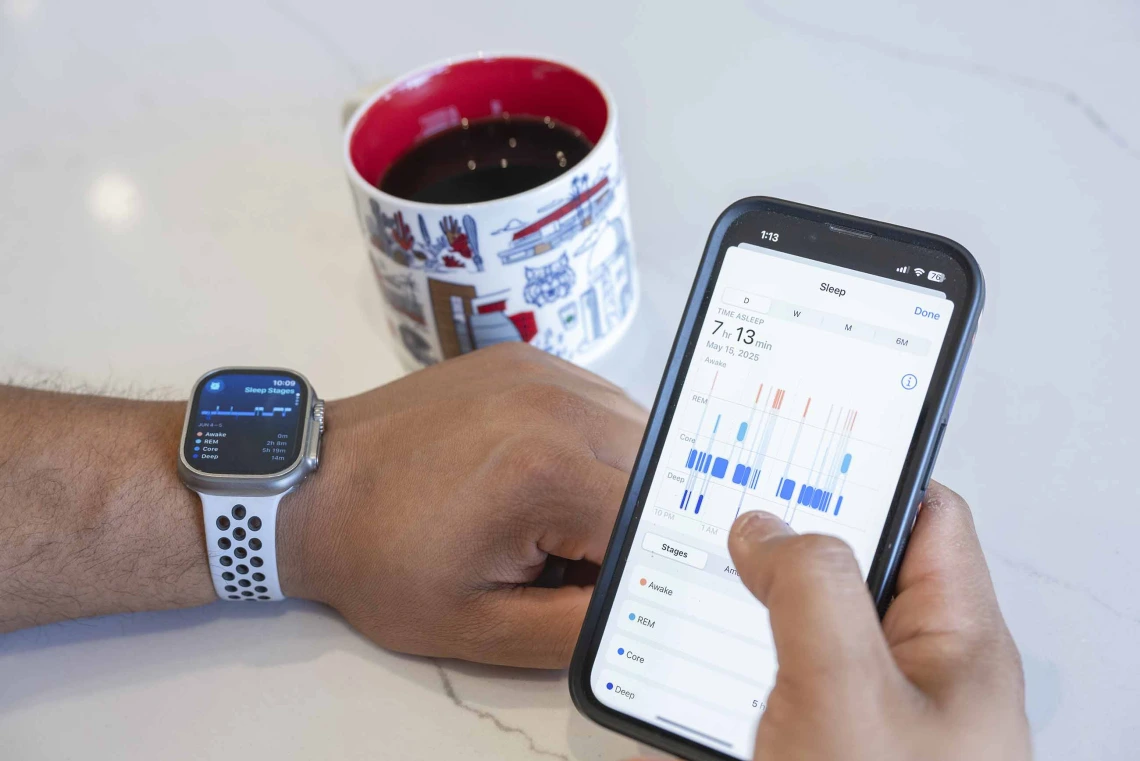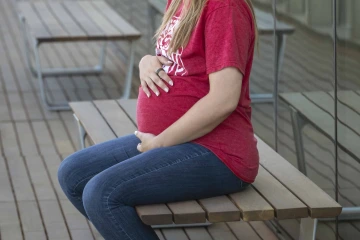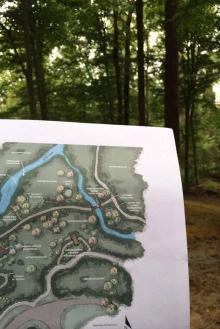Smart sensors and smarter health: How AI and wearables are reimagining preventive health care
University of Arizona Health Sciences researchers are harnessing artificial intelligence and wearable tech to forecast labor, detect stress and transform how we monitor our health – before symptoms appear.

The combination of artificial intelligence and wearable devices provides unlimited new opportunities to improve human health through research.
Photo by Noelle Haro-Gomez, U of A Health Sciences Office of Communications

Shravan Aras, PhD, oversees sensor analysis and smart health platforms for the Center for Biomedical Informatics and Biostatistics.
Photo by Noelle Haro-Gomez, U of A Health Sciences Office of Communications
When it comes to automobiles, no matter how well they are maintained, at some point the check engine light is going to come on. Inevitably, a look under the hood or trip to the mechanic is in order. The human body doesn’t have a check engine light, but wearable sensors could fill that role for people thanks to the power of data.
“Most of us wear health and fitness trackers on our wrists or fingers, and that’s an amazing window into our biology and how we operate,” said Shravan Aras, PhD, assistant director of sensor analysis and smart health platforms at the University of Arizona Health Sciences Center for Biomedical Informatics and Biostatistics.
Aras, who is also an assistant research professor, wants to help his fellow scientists get the most out of wearable sensors by incorporating them into research studies and optimizing the way wearable data is explored and analyzed. The timing is perfect, as the growth of artificial intelligence and machine learning has created tremendous opportunities for advancement in the field.
“It’s always been fascinating to me that you can build something out of nothing, like writing code to build tools. I love being able to write code, do analysis, create the hardware and see it being used by the end users,” said Aras, a who got his doctorate in computer science from the U of A. “I’ve always looked at computer science not in isolation, but as a collaborative tool – computer science being applied to different domains to solve really complicated and challenging problems.”
Using AI to predict labor onset
One such challenge is accurately predicting when a pregnant woman will go into labor. Due dates are calculated by counting 40 weeks from a woman’s last menstrual period, though in humans, gestation lengths can vary from 37 to 42 weeks. No clinical tools can provide an accurate indication of impending labor, leaving pregnant women to self-report signs of labor – a method with a high rate of false positives.

Researchers used data from smart rings and AI to develop a model that can predict labor onset.
Photo by Noelle Haro-Gomez, U of A Health Sciences Office of Communications
When labor appears without warning, maternal health can suffer due to unplanned home births, inadequate time for health care professionals to intervene in preterm births, or recommendations for earlier labor induction if a woman lives far from a hospital, for example.
Certified nurse-midwife Elise Erickson, PhD, an associate professor of physiology in the U of A College of Medicine – Tucson and BIO5 Institute member, was looking for solutions. She invited Aras to collaborate on a study investigating the feasibility of predicting labor onset using temperature data, which is commonly done in animals. In humans, temperature can help determine ovulation and fertility timing.
“Companies that do fertility and ovulation tracking take temperature readings once a day. There is a relationship between the hormone progesterone and temperature, which is how they can figure out when a person is ovulating,” Aras said. “With pregnancy, there are a whole lot of different things going on in the body. It’s not as simple as figuring out if the temperature is going lower or higher. For labor prediction, daily temperature readings do not give you a cohesive pattern of when somebody might go into labor.”
The research team partnered with a wearable sensor company that used a ring to track temperature readings every minute rather than every day. With an enormous amount of data at his disposal, Aras led efforts to develop a deep neural network-based AI model to analyze the data.
Deep neural networks simulate the activity of the human brain. They are built in layers, with one input layer to accept data and one output layer that generates the result. In between are multiple levels of hidden layers that perform complex calculations, similar to how the brain processes information. In addition to processing the data, deep neural networks learn from the data by using algorithms to compare its prediction with the output and improve accuracy.
By applying deep learning techniques to continuous body temperature data, the researchers were able to accurately predict the day of labor onset. The final model correctly predicted labor start for 79% of spontaneous labors within a 4.6-day window at seven days before true labor, and 7.4-day window at 10 days before true labor.
“We were able to develop deep neural network-based AI models that took all of this very high frequency temperature data – one data point per minute of temperature – and come up with a predictive output of when a mother might go into labor,” Aras said.
The team hopes to test the model in a larger study to further refine its clinical applicability. Their goal is to develop software that could be added to existing wearable products or medical devices.
Sensing stress
In other research, Aras is focusing on optimizing the use of data collected by sensors. He was the first author on a paper, “Is Greener Better? Quantifying the Impact of a Nature Walk on Stress Reduction Using HRV and Saliva Cortisol Biomarkers,” published in the International Journal of Environmental Research and Public Health.

Participants walked the Green Road at Walter Reed National Military Medical Center as part of a research study that examined stress responses.
Photo courtesy of Esther Sternberg, MD
The research utilized data collected eight years ago at the Walter Reed National Military Medical Center in Bethesda, where the “Green Road” was built. The Green Road is a two-acre garden located in an eight-acre woodland ravine surrounding a natural stream. Its accessible 1.2-mile woodland path is one of the largest wild-type healing gardens in the nation.
Participants walked for 20 minutes on two roads on different days: the Green Road, where they were surrounded by many trees and green foliage; and a regular urban road surrounded by concrete, buildings, parking garages, signs, and some small grassy areas and trees. Researchers from the Uniformed Services University collected heart rate variability metrics from a wearable sensor, cortisol measurements from saliva samples, and self-reported mood and mindfulness scales. The U of A Health Sciences research team, which included Esther Sternberg, MD, a professor and research director for the Andrew Weil Center for Integrative Medicine at the College of Medicine – Tucson, and J. Ray Runyon, PhD, an assistant research director at the Weil Center and assistant research professor at the College of Agriculture, Life and Environmental Sciences, analyzed the data, looking for significant differences in stress responses among participants.
“I was fascinated by the idea,” said Aras, who shifted his research focus from satellites to health sciences after working with two College of Medicine – Tucson mentors – cardiothoracic surgeon and former assistant professor Zain Khalpey, MD, PhD, and John Konhilas, PhD, a professor of physiology.
“Because I had worked with cardiac signals like ECGs, I had some understanding of different heart rate variability metrics. Instead of doing just a simple before and after measurement of heart rate variability, I wanted to figure out how the HRV is changing in between and whether that correlates with cortisol measurements taken using saliva.”
They found that taking a walk on the Green Road had a significant positive impact on the stress response compared with walking an urban path. For all participants, walking helped reduce cortisol, and walking on the Green Road compared with the urban road resulted in a higher reduction in cortisol.
The measurements of heart rate variability were not as simple, Aras said. The team found considerable individual variability in autonomic nervous system stress responses as measured by HRV, with some individuals showing a substantial positive impact on HRV and others little or none.
“We realized that changes in HRV are highly subjective based on the person’s experience,” Aras said. “There was one individual who was walking on the Green Road, and he saw a snake. You can see their HRV plummet at that point, and you can see a small spike of cortisol as well. But these are things we cannot control.”
By combining AI with wearable sensors, researchers can rapidly collect and analyze vast amounts of data, unlocking powerful new ways to enhance human health.
The Green Road study did not utilize AI, but Aras indicated an offshoot of the project currently ongoing with Sternberg, a BIO5 Institute member, and Runyon will. The current study uses AI to assess a person’s stress response via digital, sweat-based biomarkers. The team hopes to publish their findings this summer.
The two projects are the tip of the iceberg when it comes to using AI for health sciences research. Aras says AI gives researchers the ability to gather and handle significantly more data in a faster and more accessible way. Combining AI with wearable sensors, he says, presents a huge opportunity to improve human health.
“What AI has allowed us to do is create optimized and efficient models for it to start learning on its own and coming up with different inferences for us,” Aras said. “What interests me now is helping people using these different sensor devices that almost everybody wears. My goal is to be able to predict things that are nonsymptomatic and do it in a proactive manner rather than doing it reactively, where you’re trying to always keep treating the symptoms. I want to be able to predict, using sensors, that something is coming.”
Experts
Shravan Aras, PhD
Associate Director of Sensor Analysis and Smart Health Platforms, Center for Biomedical Informatics and Biostatistics, U of A Health Sciences
Assistant Research Professor, Department of Health Sciences Graduate Studies, College of Health Sciences
Elise Erickson, PhD
Associate Professor, Department of Physiology, College of Medicine – Tucson
Assistant Professor, Clinical and Translational Sciences, College of Health Sciences
Member, BIO5 Institute
Esther Sternberg, MD
Professor, Department of Medicine, College of Medicine – Tucson
Director of Research, Andrew Weil Center for Integrative Medicine, College of Medicine – Tucson
Director, Institute on Place, Wellbeing and Performance, College of Architecture, Planning and Landscape Architecture
Inaugural Andrew Weil Endowed Chair for Research in Integrative Medicine
Professor, Department of Psychology, College of Science
Professor, Nutritional Sciences and Wellness, College of Agriculture, Life and Environmental Sciences
Professor, Department of Architecture, College of Architecture, Planning and Landscape Architecture
Member, BIO5 Institute
J. Ray Runyon, PhD
Assistant Research Professor, Department of Environmental Science, College of Agriculture, Life and Environmental Sciences
Assistant Research Director, Andrew Weil Center for Integrative Medicine, College of Medicine – Tucson
Related Stories
Contact
Stacy Pigott
U of A Health Sciences Office of Communications
520-539-4152, spigott@arizona.edu

